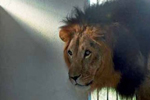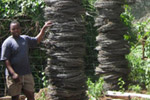
Lions hang out by a fence in Tswalu Kalahari Reserve, South Africa. Photo by: Luke Hunter.
In order for dwindling lion populations to survive in Africa, large-scale fencing projects may be required according to new research in Ecology Letters. Recent estimates have put lion populations down to 15,000-35,000, a massive drop from a population that was thought to be around 100,000 in 1960. The worsening plight of lions have pushed the researchers to suggest what is likely to be a controversial proposal: fence the top predators in.
“These findings highlight the severity of the lion conservation crisis today and the limited choices we have to ensure a future for the species,” co-author Luke Hunter the head of the lion program at Panthera, said. “No one wants to resort to putting any more fences around Africa’s marvelous wild areas, but without massive and immediate increases in the commitment to lion conservation, we may have little choice.”
While habitat loss and prey decline have heavily impacted lion populations, lion-human conflict—with human populations rising steadily and lions dropping—has only exacerbated the already difficult situation. Lions are increasingly killed by spear, poison, or gun as they are viewed as pests that prey on local livestock; in addition lions can be incredibly dangerous to nearby humans. Attacks occur frequently with some evidence showing that lack of prey and human encroachment increases the chance of lion attacks on people.
“Lions are considered so dangerous in South Africa that they can only be re-introduced after management authorities erect lion-proof fencing and agree to recapture or destroy any escaping lions,” the scientists write noting that the controversial practice of fencing in lions has “prevent[ed] most potential conflicts between lions and humans in southern Africa, yet this strategy runs counter to a long-standing conservation ethic of keeping protected areas unfenced.”
 Lion in Tanzania. Photo by: Rhett A. Butler. |
Fencing in parks brings up a number of issues including the high initial cost, the inability of animals to move naturally or migrate, and aesthetic complaints. But the study found that if lions aren’t fenced in (and humans kept out) about half the current populations could simply vanish in 20-40 years. In addition, fenced-in populations are actually cheaper to maintain. The study estimated that fencing in a reserve costs around $500 per square kilometer, while reserves without fences require conservation measures close to $2,000.
“Lion populations in fenced reserves are significantly closer to their estimated carrying capacities than unfenced populations,” the researchers write. In comparing fenced-in reserves versus open ones, the scientists also found that fenced reserves were expected to keep lion populations near carrying capacity in the long-term. These lions are also “less sensitive” to human densities nearby “presumably because fences reduce poaching, minimize habitat loss, curtail illegal grazing and prevent direct conflict,” the researchers write.
“It is clear that fences work and unfenced populations are extremely expensive to maintain,” said lead author, Craig Packer, with the University of Minnesota.
The authors note that it may even be time to start fencing in villages and towns that are situated in or adjacent to wildlife territory, i.e. fence in people to keep predators out.
“In some cases, human-occupied zones within larger wildlife-dominated ecosystems may even need to be fenced as enclaves (e.g. 30,000 people live in 40 villages inside Mozambique’s Niassa National Reserve), as has been recommended for reducing conflicts between wolves and
ranchers in livestock-production areas around Yellowstone National Park.”
However park management proceeds, the scientists say that significantly more funds will be necessary to keep lion populations from falling even further.

Adult female and two male juvenile lions in the Masai Mara, Kenya. Photo by: Benh Lieu Song.

Lion and cub in Phinda Private Game Reserve, South Africa. Photo by: Luke Hunter.
CITATION: Packer, C. et al. 2013. Conserving large carnivores: Dollars and fence. Ecology Letters DOI: 10.1111/ele.12091
Related articles
Geneticists discover distinct lion group in squalid conditions

(02/04/2013) They languished behind bars in squalid conditions, their very survival in jeopardy. Outside, an international team of advocates strove to bring worldwide attention to their plight. With modern genetics, the experts sought to prove what they had long believed: that these individuals were special. Like other cases of individuals waiting for rescue from a life of deprivation behind bars, the fate of those held captive might be dramatically altered with the application of genetic science to answer questions of debated identity. Now recent DNA analysis has made it official: this group is special and because of their scientifically confirmed distinctiveness they will soon enjoy greater freedom.
Three developing nations move to ban hunting to protect vanishing wildlife

(01/21/2013) Three developing countries have recently toughened hunting regulations believing the changes will better protect vanishing species. Botswana has announced it will ban trophy hunting on public lands beginning in 2014, while Zambia has recently banned any hunting of leopards or lions, both of which are disappearing across Africa. However, the most stringent ban comes from another continent: Costa Rica—often considered one of the “greenest” countries on Earth—has recently passed a law that bans all sport hunting and trapping both inside and outside protected areas. The controversial new law is considered the toughest in the Western Hemisphere.
Lion population falls 68 percent in 50 years

(12/04/2012) African lions, one of the most iconic species on the planet, are in rapid decline. According to a new study in Biodiversity Conservation, the African lion (Panthera leo leo) population has dropped from around 100,000 animals just fifty years ago to as few as 32,000 today. The study, which used high resolution satellite imagery to study savannah ecosystems across Africa, also found that lion habitat had plunged by 75 percent.
Illegal hunting threatens iconic animals across Africa’s great savannas, especially predators

(10/25/2012) Bushmeat hunting has become a grave concern for species in West and Central Africa, but a new report notes that lesser-known illegal hunting in Africa’s iconic savannas is also decimating some animals. Surprisingly, illegal hunting across eastern and southern Africa is hitting big predators particularly hard, such as cheetah, lion, leopard, and wild dog. Although rarely targets of hunters, these predators are running out of food due to overhunting and, in addition, often becoming victims of snares set out for other species.
King of the jungle: lions discovered in rainforests
(08/13/2012) Calling the African lion (Panthera leo) the ‘king of the jungle’ is usually a misnomer, as the species is almost always found in savannah or dry forests, but recent photos by the Germany-based Nature and Biodiversity Conservation Union (NABU) document lions in Ethiopian rainforests. Taken in the Kafa Biosphere Reserve, the photos show a female lion hiding out in thick montane jungle.
New campaign targets snares in effort to save world’s big cats

(06/05/2012) Last summer, a wild Sumatran tiger—one of only a few hundred surviving on the island—made news in a story that did not have a happy ending. The cat had become entangled in a snare in a logging concession owned by Asia Pulp and Paper (APP). The tiger spent seven days without food or water before wildlife rangers found it, but its snared right paw was a bloody black mess. Although the rangers were able to sedate and free the cat, it died shortly thereafter from its wounds.